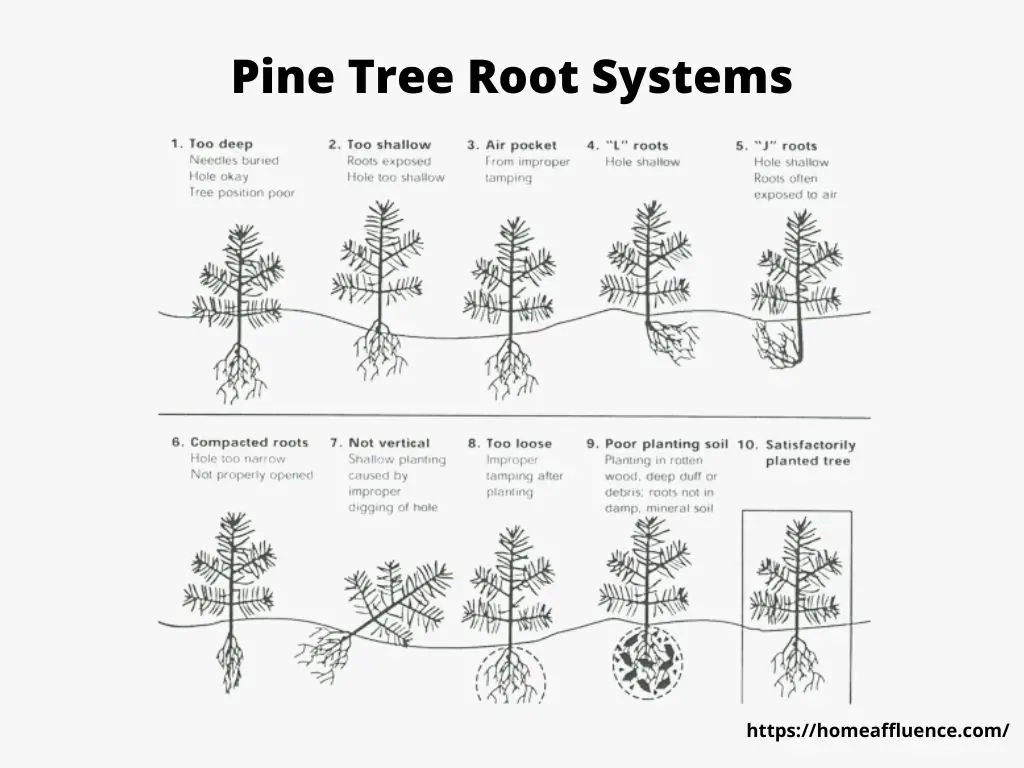Pine trees are more than just majestic giants that dot our landscapes – they’re also master soil engineers. Their intricate root systems are crucial in maintaining the tree’s health and the surrounding environment. From anchoring the tree to the ground to facilitating nutrient exchange with other plants, these roots are the unsung heroes of the forest.
In this article, we’ll look closer at the fascinating world of pine tree root systems and discover the unique adaptations that make them vital to our planet’s ecosystem.
Pine Tree Root Systems
Pine trees’ primary roots grow downward, while the secondary roots spread horizontally as far as the branches can reach. Typically, the length of these lateral roots is most significant near the surface, but it increases with depth.
The primary roots are located below the soil’s surface. In comparison to their height, pine trees have an extensive root system. It has a root system composed of primary roots that grow downward into the soil for water. This tree is firmly rooted in its soil due to the immense depth of these roots.

Too deep
If a pine tree is planted too deep, its taproot may struggle to grow straight down, and the lateral roots may not be able to access enough oxygen, water, and nutrients. The roots may also be more rot-resistant due to insufficient drainage or waterlogged soil.
Too shallow
If a pine tree is planted too shallow, its roots may not be able to establish themselves properly in the soil, making it more vulnerable to drought stress or uprooting during high winds or storms. The shallow root system may also be more susceptible to damage from foot traffic, lawnmowers, or other landscaping activities.
Air pocket
If a pine tree is planted in soil with an air pocket, the roots may struggle to penetrate the soil and access water and nutrients. The root tips may become damaged or die due to a lack of oxygen or drying out, and the tree may exhibit signs of stress, such as wilting or yellowing leaves.
J roots
J roots can occur when a pine tree is planted in a container or root ball, and the roots grow in a circular pattern instead of outward. Over time, the roots may become tangled and restricted, leading to stunted growth or eventual death of the tree.
Compacted roots
If the soil around a pine tree is compacted, the roots may not penetrate the soil and access enough water and nutrients. This can result in stunted growth, yellowing leaves, or other signs of nutrient deficiency.
Not vertical
If a pine tree is planted at an angle or with the root ball exposed, the roots may not be able to establish themselves properly in the soil. This can lead to the tree leaning or falling over, or it may struggle to absorb enough water and nutrients to support healthy growth.
Too loose
If the soil around a pine tree is too loose, the roots may not be able to anchor the tree properly or access enough water and nutrients. The tree may be more vulnerable to uprooting or damage from high winds or storms.
Poor Planting Soil
If the soil around a pine tree lacks nutrients or has poor drainage, the tree may struggle to establish a healthy root system. The roots may be more vulnerable to disease or damage, and the tree may exhibit signs of stress, such as yellowing or wilting leaves.
Satisfactorily Planted Tree
A pine tree planted in well-draining soil, with the roots properly spread out and the root ball at the correct depth, will be better able to establish a healthy root system. The tree’s roots will be able to access enough water and nutrients to support healthy growth, and the tree will be more resistant to environmental stressors such as drought or high winds.
It is not a common species; you can distinguish it by a few characteristics. It is tall and slender, with a conical, pointed crown and a trunk that can significantly thicken with age. The branch tips have a slight upward angle.
Type of Pine Tree Root System
Pine trees have a complex root system that can be divided into two main types of roots: lateral roots and taproots.
Lateral roots:
These roots are smaller and more numerous, spreading horizontally from the tree trunk. They are responsible for absorbing water and nutrients from the soil and supporting the tree. Lateral roots are often found in the top 6 to 12 inches (15-30 cm) of soil.
Taproot:
The taproot is the main root that grows from the trunk and anchors the tree to the ground. It is typically larger and stronger than the lateral roots and can extend up to several feet deep into the soil. The taproot provides additional stability and support to the tree, especially during high winds or storms.
The lateral roots and the taproot work together to provide the tree with the necessary water, nutrients, and stability to grow and thrive. It is important to note that pine trees have a shallow root system, so they may be more susceptible to damage from high winds or soil disturbances. When planting or landscaping around pine trees; care should be taken to avoid damaging the root system.
How Do Pine Tree Root Systems Work?
As the trunk and branches of the pine tree continue to grow, the tap root continues to anchor it firmly in place.
- It has soil moisture and inorganic nutrients
- Starch has a substance to store food (energy source).
- The reproductive process of pine trees also involves the roots.
Frequently Asked Questions
Should I cut down pine trees?
If you must regularly spray for insects or treat fungal infections, you should eliminate them. Removing trees encroaching on your property, other buildings, or power lines may also be necessary.
It would be best to prune pine trees in the spring, but you can repair damage anytime. Although it is essential to repair broken or mangled branches immediately, late summer and autumn are the worst times to prune. You must also remove leaning, storm-damaged, or dead pine trees.
Do pine tree roots cause damage?
Several centimeters below the soil’s surface, numerous pine tree roots threaten the structural integrity of surfaces such as sidewalks, driveways, and patios. Pine trees have non-invasive root systems; however, the roots follow the water when the soil dries out. Driveways and sidewalks have little effect on a tree’s ability to send out new roots because they are typically only a few inches deep.
Do pine trees cause foundation problems?
Pine trees are distinguished by their vertically oriented root systems. Therefore, pine trees will have little to no effect on your home’s structure.
Some tree species are more likely to cause severe foundation damage, but any tree can do so. Pine trees (Pinus) are a popular and aesthetically pleasing addition to many lawns; fortunately, their fibrous, shallow roots make them safe for planting near structures. When designing your garden, remember to consider the tree’s root system. Trees do not destroy foundations, but tree roots can widen existing cracks.
Are pine trees good for the backyard?
Pine trees are an excellent addition to any backyard because they prevent soil erosion. Some tree species are more likely to cause severe foundation damage, but any tree can do so. Pine trees (Pinus) are a popular and aesthetically pleasing addition to many lawns; fortunately, their fibrous, shallow roots make them safe for planting near structures.
Numerous pine trees have deep roots that hold the soil in place, preventing water and wind erosion. In addition to protecting the soil from wind and rain, the thick needles shield the ground beneath the tree.
How far should a pine tree be from a house?
As a general guideline, the enormous trees over 70 feet tall should generally be located at least 20 feet away from the building. Small trees under 30 feet in height should be grown 8 to 10 feet away from the house, while moderate trees up to 50 feet in height should be placed 15 feet away.
How deep is the root system of a pine tree?
Most pine tree rhizomes go down approximately 3 feet, but they may go considerably deeper in dry sandy soils. Supporting the tree’s above-ground portion, the roots also draw water and minerals from the soil.
Conclusion
To end the topic, pine tree root system, it is wise to say that trees of any type can damage the foundation, but some results are awful. Pine trees are the best choice to grow in your yards because they are attractive landscape features.
Fortunately, pine tree root systems are safe to grow near your homes. So you should only consider the pine trees’ root system when deciding on your landscapes, as they help enhance your property’s beauty and cost.




